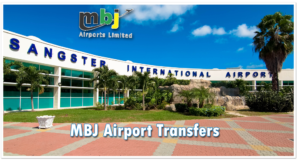Sangster International Airport (MBJ), is an international airport located 3 mi (4.8 km) east of Montego Bay, Jamaica. It is one of the largest, busiest and most ultra-modern airports in the Caribbean capable of handling nine million passengers per year. Sangster is often referred to as the gateway to the Caribbean, and is the Caribbean hub for many airlines. It serves as the most popular airport for tourists visiting the north coast of Jamaica. MBJ is currently the busiest of Jamaica’s three international airports, the others being the Norman Manley International Airport located in the capital city of Kingston and the Ian Fleming International Airport located in Boscobel, Saint Mary Parish, Jamaica. The airport is named after Jamaican Prime Minister Sir Donald Sangster.

Sangster International Airport History
Sangster International Airport in Montego Bay, St. James, was first conceived in 1936 when the site now housing the Sangster International Airport was identified as one suitable for the construction of an airport in the town of Montego Bay. Originally named the Montego Bay Airport, a decision was made to build the runway in 1940, and the actual construction of the facility was completed on February 18, 1947. At the time of its completion, the town of Montego Bay was more like a playground for the rich and famous, and was considered then, one of the premier vacation spots within the Caribbean, just as it is today.
The first international airline to fly into the Montego Bay Airport was Pan American Airways, and the airport, which in comparison to today’s standards, was more like a small aerodrome, was operated by Pan American until September 30, 1949, when the Jamaican government took control of the facility. However, the Sangster International Airport, as known today, is nothing like it was in the early days. One of the most noticeable differences was that initially, the terminal building was on the northern side of the runway but was shifted to the southern side of the runway during one of the several upgrading exercises that took place at that facility, which was necessitated by the growth in air traffic over the years. Plans for the construction of a new terminal at its present location, on the southern side of the runway, were announced in July 1955. the plans for the new terminal building was part of what turned out to be a continued upgrading and restructuring of the facility, to enable it to cope with the growth in traffic. The new terminal was built and opened on July 7, 1959, with a capacity to accommodate 500 passengers per hour, and parking for seven aircraft at a time.
Over the years, the upgrading process was a continuous one, ultimately the facility had grown into the larger of the two international airports in Jamaica, handling approximately 3.7 million passengers per annum in 2007, and has seen an increase in passenger and aircraft movement since the start of 2008. The management and partners of the airport are currently seeking to increase the number of passengers from Asia, and are working with Brazil to receive more non-stop service from that country.
Sangster International Airport (IATA: MBJ) is located in Montego Bay, Jamaica. It is one of the busiest airports in the Caribbean and serves as a major gateway for travelers visiting Jamaica. Here are some key details about Sangster International Airport:
- Location: Sangster International Airport is situated in Montego Bay, which is a popular tourist destination on the northwestern coast of Jamaica.
- Facilities: The airport offers a range of facilities and services for travelers, including duty-free shops, restaurants, car rental services, currency exchange, and lounges.
- Terminals: The airport has two main terminals: the Sangster International Terminal and the Domestic Terminal. The International Terminal handles most international flights, while the Domestic Terminal caters to domestic and some regional flights.
- Airlines: Sangster International Airport is a hub for several Jamaican airlines and serves as a key destination for various international carriers, connecting travelers to major cities worldwide.
- Transportation: Travelers can access various transportation options from the airport, including taxis, private airport transfers, and rental cars, making it convenient to reach their desired destinations in Jamaica.
- Location Advantages: Montego Bay’s location on Jamaica’s north coast provides easy access to popular tourist areas like Ocho Rios, Negril, and the capital city, Kingston.
- Tourist Attractions: The airport’s proximity to Montego Bay allows travelers to explore the city’s stunning beaches, vibrant nightlife, and numerous tourist attractions.
- Customs and Immigration: Sangster International Airport has customs and immigration facilities to process incoming and outgoing passengers, ensuring a smooth entry and exit process.
Overall, Sangster International Airport is a key entry point for travelers arriving in Jamaica, offering a range of services and easy access to the country’s beautiful beaches, cultural sites, and tourist destinations.
Recently, there was a change in management at the Sangster International Airport following the change in the consortium that operates this facility. Relations between the new management and unions have been difficult, with a strike in November 2007 and in November 2009.
The airport is the busiest airport in the English-speaking Caribbean. It has won the World Travel Awards “Caribbean’s Leading Airport” for the years 2005, 2009–2011 and is also a nominee for 2012.
In December 2013, the airport will be the first English-Speaking Caribbean country to receive flights with a Boeing 787 aircraft by Thomson Airways from London, England











